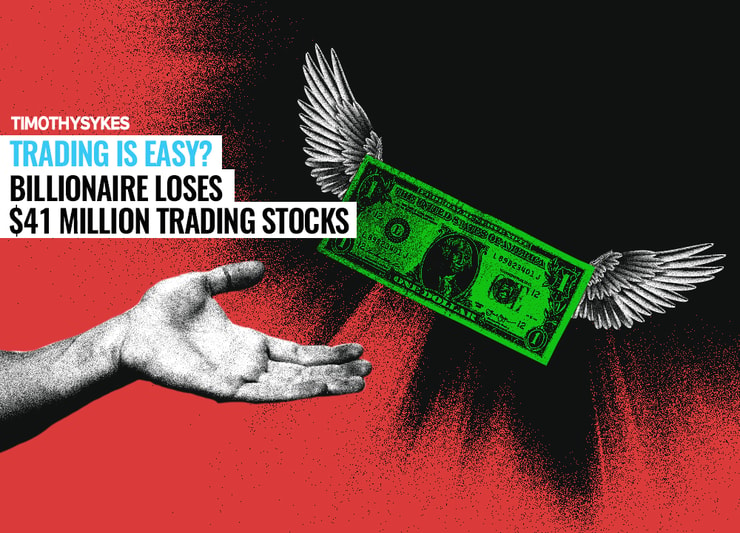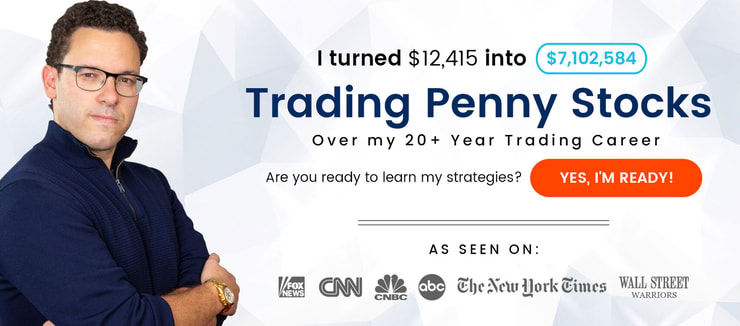You could repeat it a thousand times, like a mantra or a prayer … Trading is easy … Trading is easy … Trading is easy…
Unfortunately, that doesn’t make it true. Trading requires preparation and knowledge. It requires self-discipline and experience. You have to develop pattern recognition and a risk management strategy.
The point is, there’s a lot to learn. Especially at first. Which is why the story of the billionaire who lost $41 million trading stocks is an important cautionary tale.
Before we dive into this wild story, let’s pause to reflect on something very important…
Today is more than just a Friday … It’s the 19-year anniversary of 9/11 — one of the most tragic days in American history.
We remember the innocent victims and the heroes who sacrificed their lives attempting to save them. We remember the victims’ families. We remember the survivors. We remember those we’ve lost to 9/11-related illnesses and those who suffer today. We stand in tribute. We will never forget.
Table of Contents
- 1 Trading Is Easy? Not So Fast
- 2 Blinded by Volatility
- 3 9 Lessons From Losing $41 Million Trading Stocks
- 3.1 Being Good at Business Doesn’t Make Trading Easy
- 3.2 Smart People Have an Edge, Right? WRONG!
- 3.3 Trading Is About Pattern Recognition
- 3.4 Fish in a Small Pond
- 3.5 Understand the Limitations and Bank on Them
- 3.6 Expect to Make Nothing
- 3.7 Learn to Take Singles
- 3.8 Don’t Go for Home Runs
- 3.9 Preparation Is Key
- 4 Trading Education Resources
Trading Is Easy? Not So Fast

2025 Millionaire Media, LLCOn September 6, billionaire Yusaku Maezawa tweeted that he’d lost 4.4 billion yen day trading stocks. That’s $41 million in losses.
Maezawa is the founder and former CEO of online fashion company Zozo. He sold his stake in the company for $900 million and is worth roughly $3.5 billion.
Blinded by Volatility
In the introspective tweet, Maezawa said he was “… blinded by the turbulent stock market.” He said he lost 4.4 billion yen “as a result of unfamiliar short-term trading.” He also said he regrets it and contemplated how many people he could’ve saved with 4.4 billion yen. (Translation by Google.)
Maezawa vowed to make the money back in his business. Zero Hedge referred to it as “chasing your losses.”
So here’s a guy who’s obviously very smart. He probably thought that would give him an edge in trading stocks. He might have let the volatility blind him. And because he wasn’t prepared … he lost.
Don’t underestimate a volatile market. And don’t chase. Instead, prepare. You can start with my “Volatility Survival Guide.”
Fool Me Once, Shame on You. Fool Me Twice…
He’s one of the richest people in the world and very successful in business. But how did he get this one wrong? I don’t want to rub in anyone’s trading losses. And it’s very likely Yusaku Maezawa can recover from it.
But I want newbies to understand that trading isn’t as easy as they might think. The ‘trading is easy’ mindset can get a lot of ‘pandemic day traders’ into a lot of trouble.
Yusaku Maezawa’s loss teaches all kinds of lessons. I want people to learn from that.
9 Lessons From Losing $41 Million Trading Stocks

2025 Millionaire Media, LLCThere are many academic studies showing 90% of traders lose. Even congressional hearings support that number. What a lot of people don’t know is that most traders give up within 90 days. Why? Because that’s how long it takes to blow up their account.
So it’s no surprise that a billionaire lost money trading stocks when he didn’t know anything about it. But it doesn’t sound like he followed my rule #1 about cutting losses quickly. It shouldn’t take $41 million in trading losses to learn the lessons…
Being Good at Business Doesn’t Make Trading Easy
Business success doesn’t translate into trading success. I’ve seen this before. I have students who say, “I’m an amazing entrepreneur. I thought trading was easy and that I could do it. I’m not used to losing.”
Welcome to trading!
Still, you’d think a billionaire businessman would get it right all the time, right? He’s gotta be pretty smart. But that leads to another fallacy about trading…
More Breaking News
- BigBear.ai Shake-Up: What’s Going On?
- Will Transocean Continue to Waver?
- Fidelity National Takes Bold Steps: What’s Next?
Smart People Have an Edge, Right? WRONG!
Recognize that no matter how smart you are or how good at math you are, it doesn’t matter. With trading, it also doesn’t matter if you’re bad at math. You don’t have to be smart.
What matters?
Trading Is About Pattern Recognition
Trading, especially penny stocks, is all about pattern recognition. You can increase your knowledge (and odds of success) through preparation. The more prepared you are on every trade, the better your chances.
Don’t think patterns are everything, though. Like I always say, use all seven indicators in the Sykes Sliding Scale. Pattern is only one. But if you don’t recognize the patterns then the rest of the indicators won’t help much.
I would venture to guess Yusaku Maezawa wasn’t very interested in penny stocks. I’m guessing he was trading Amazon, oil, and everything CNBC features. So again, it’s not a total surprise that he lost.
But it would be interesting if he tried penny stocks. With penny stocks, you can have better odds with less competition. Learn the basics with this FREE penny stock guide.
The thing is, trading penny stocks doesn’t really move the needle compared to what he was trading. Penny stocks are a much smaller game and it’s not scalable. Even if he was one of the most successful penny stock traders in the world, it would be a far cry from what he’s probably used to…
Fish in a Small Pond
Trading forex or big companies is like trading in the ocean. A lot of the most successful rules in trading are counterintuitive. Trying to tackle big industries with very little trading education/experience is crazy. You don’t have an edge.
People ask me all the time, “What’s your technology? What computer do you use? How many screens?” People think that gearing up with technology will increase their odds or give them an edge.
I use one laptop. But that’s because I fish in a small pond. Trading penny stocks is more like trading in a small pond.
The question is…
What do you want to do?
You could fish in a small pond where, frankly, it can be easier. But there aren’t as many fish to catch. Or you could fish in the ocean. There are a lot of fish to catch, but if you get caught in the perfect storm your account will blow up.
Understand the Limitations and Bank on Them
I recognize the limitations with penny stocks, and I count on them. Remember, the limitations keep big Wall Street traders away. That lowers the level of competition.
So while other people trade bigger stocks and lose ($41 million … ouch). I can make $2,000 or $3,000 per day.* Some days in this hot market, I make $5,000 per day. The Wall Street guys laugh at me. But I couldn’t care less.
(*My trading profits are exceptional. Individual results will vary. I have the benefit of dedication, hard work, and 20+ years of experience trading penny stocks. All trading is inherently risky. Always do your due diligence and never risk more than you can afford to lose.)
Expect to Make Nothing
So many traders always focus on the money, but it’s also about the lessons. What would have happened if Maezawa had focused on the process? What if he cut losses quickly and worked on pattern recognition. Or what if he’d taken smaller positions to learn how to trade first?
I’d rather you really focus on the lessons, and just expect to make nothing.
His big losses really drive home something I say all the time…
Learn to Take Singles
Singles add up over time. Most of my trading profits are made up of small wins. Trading penny stocks can be rinse and repeat after you figure out what works for you. After you learn the nuances. And after you gain enough experience.
So when someone comes along and says, “Trading is easy,” I just have to laugh. Maybe trading is easy … just not for the first few years.
Don’t Go for Home Runs
Who knows if it took swinging for home runs to lose $41 million. But it wouldn’t surprise me. Too many traders try to make up for losses by taking big trades. They want to make it up with one big win.
When you focus on the process and follow the rules, your wins should be bigger than your losses. (I trade with these rules.) You don’t have to lose big. But if you do, trying to make it all back at once is a recipe for disaster.
Preparation Is Key
You have to study and prepare first — don’t have thoughts of overnight riches. Forget that. Focus on learning the process of trading. Focus on your education and expect to take losses as you learn. Obviously, don’t expect to lose $41 million…
Trading Education Resources
Understand that you have time. The past few months were amazing. A lot of newbie traders jumped in and made money. But some of them will have learned the wrong lessons.
If you want to stay in the game long enough to avoid being one of the 90%, you MUST study. Every day.
Start here…
“The Complete Penny Stock Course”
My student Jamil wrote “The Complete Penny Stock Course.” It answers SO many questions.
Including…
- How to choose a risk-management strategy. This is crucial to know before you start day trading. This alone could have saved millions in losses for our billionaire friend (page 133).
- Why three out of four stocks follow the overall market (page 101).
- How to play my favorite pattern. And why it’s important to look at the stock’s history first (page 337).
- If you want to short sell, you better understand THIS. (And be willing to get up early) (page 252).
- Plus, a LOT more…
It really distills my teachings down into a user-friendly, well-organized format. Every trader and aspiring trader should read it!
Get more information and order “The Complete Penny Stock Course” here.
30-Day Bootcamp
The Bootcamp is a big hit. Matthew Monaco and I didn’t know it would be this popular. We wanted to put together something to help people take advantage of the hot market as fast as possible.
One of the most frequently asked questions about the Bootcamp is “Do I have to do it in 30 days?” No. You get lifetime access. 30 days is only a suggestion.
What will you add to your knowledge account when you get the 30-Day Bootcamp?
- My seven steps to trading success (Day 13).
- The best pattern for anyone trading under the PDT rule (Day 14).
- Why anticipation can crush you, but reaction can often be profitable (Day 15).
- If you want to make money as a retired trader, avoid THIS (Day 25).
- The one trade rule you MUST obey (Day 10).
PLUS: You’ll receive “The Complete Penny Stock Course” AND “Pennystocking Framework” as bonuses. No brainer, right?
Get more information and start the 30-Day Bootcamp here.
Finally, if you want mentoring, apply to my…
Trading Challenge
All my top students are in the Trading Challenge.
Why? Mentoring, live webinars, and my favorite chat room. And live trade alerts and insight. Plus DVDs, video lessons, archived webinars, and manuals. It’s a total immersion program.
It’s not for everyone and not everyone who applies gets accepted. But if you’re serious about learning to trade and ready to get to work, I’m looking for dedicated students. Is that you?
Apply for the Trading Challenge here.
What do you think of $41 million of trading losses? Is trading easy? Comment below, I love to hear from all my readers!












Leave a reply